2025-12-17 Wed
■ #6078. an one man --- an 単語が数詞ではなく不定冠詞と分かる例 [article][numeral][grammaticalisation][syntax][me]
歴史的に文法化 (grammaticalisation) を扱う研究をみていると,ある言語項が文法化したといえるのはいつか,どんな例が現われれば確実に文法化したと言い切れるか,という問題に出くわす機会がある.文法化は形式上の問題であると同時に意味の問題でもあるが,意味は研究者が自説に都合よく「読み込む」ことができてしまう.したがって,「この例文では文法化がすでに生じている」と主張するためには,なるべく主観を排して,客観的に確認でき,かつ説得力のある言語学的根拠を示す必要がある.特に形式的な観点から示せるとベストである.
例えば,数詞 one はいつから不定冠詞 (indefinite article) へ文法化したのか,という問題を考えてみる.音韻形態的には古英語 ān が弱まって an や a となったときだと考えたくなるが,中英語期には現代に連なる one を含め,多種多様な強形・弱形が現われており,それぞれが数詞とも不定冠詞とも解釈できる例があり,決着がつかない.1200年前後に書かれた討論詩 The Owl and the Nightingale の ll. 3--4 の "Iherde ich holde grete tale / An hule and one niȝtingale." などを参照されたい.
しかし,統語的な観点から迫る方法がありそうだ.それは標題の an one man のように,2つの "one" が並んで現われるケースだ.この場合,1つめの an が不定冠詞で,2つめの one が数詞である,と結論づけるのは自然であり異論はないだろう.前者は「初出・存在」を標示する文法的な機能を担っているのに対し,後者は「1人・個人」を意味する数詞として機能している語として解釈できる.これは架空の句ではなく,Mustanoja が後期中英語の Gower より引いた実在の表現である.以下に引用する (291) .
For thei be manye, and he [i.e., the king] is on; And rathere schal an one man With fals conseil, for oght he can, From his wisdom be maad to falle (Gower CA vii 4161)
現代英語では「不定冠詞 a + 数詞 one + 名詞」という句は許されないが,中英語にはこれがみられた(もっとも,非常にまれだったことは Mustanoja (291) も述べているが).ちなみに「定冠詞 the + 数詞 one + 名詞」は現代英語でも on the one hand, the one thing, the one exception などと普通にみられる.
・ Mustanoja, T. F. A Middle English Syntax. Helsinki: Société Néophilologique, 1960.
2025-11-28 Fri
■ #6059. take --- 古ノルド語由来の big word の起源と発達 [etymology][loan_word][lexicology][grammaticalisation][phrasal_verb][asacul][polysemy][collocation][particle][idiom][old_norse][french][contact][borrowing]
明日29日(土)の朝日カルチャーセンター新宿教室での講座では,take という英単語に注目し,その驚くべき起源と発達をたどる予定でいる.この単語は,英語語彙のなかでも最も多義的な単語のひとつである.その意味の広がりと,しかも古ノルド語からの借用語であるという事実に,改めて驚かざるを得ない.
OED 第2版(冊子体)で調べると,動詞 take の項目だけで第17巻の pp. 557--72 を占める.あの OED の小さな文字まで,47コラムほどの分量である.日本語では一般に「取る」と訳されることが多いが,この「取る」という動作概念があまりにも一般的で抽象的であるがゆえに,そこから無数の意味的な発展や共起表現が派生してきた.まさに,英語語彙のなかでも有数の "big word"と言って差し支えないだろう.
この多義的な動詞の歴史をたどると,まず根源にあるのは積極的な行動としての「取る」という意味だ.場所や土地を目的語として「占拠する」といった軍事的な含みをもつ語義だ.ここから派生して,モノを「取る」ことは,それを「自分のものにする」こと,すなわち「所有権を得る」という意味が展開してくる.さらに,モノや人を目的語にとって,何かを「もっていく」,誰かを「連れて行く」へも発展する.
この「積極的に取りにいく」という性質が希薄化していくと,むしろ意味は反対の方向へと向かう.すなわち,「受け取る」「引き受ける」といった,比較的消極的な意味が生まれてくるのだ.
さらに興味深いのは,意味がより希薄化し,いわば文法化 (grammaticalisation) へと進むケースである.例えば,take a walk や take a bath のように,単に特定の動作を行うことを示す,あたかも do に近い補助動詞的な役割を帯び始めるのだ.ここでは「取る」や「受け取る」といった具体的な意味はもはや感じられず,文法的な機能を果たす道具として用いられているにすぎない.この現象は,動詞の語彙的意味が薄れていく過程を示している.
また,take の語彙的価値を高めているのは,句動詞 (phrasal_verb) を生み出す母体としての役割である.take away, take in, take off, take out など,後ろに小辞 (particle) を伴うことで,数限りない表現が生み出されている.これらは1つひとつが独立した意味を持つため,英語学習者にとっては厄介な暗記項目となるが,その豊かさが,英語という言語の表現力を支えている.
加えて,take effect, take place, take part in のように特定の名詞と結びついてイディオム (idiom) を形成する用法も,現代英語では多数存在する.この背景には,中英語期にフランス語の対応する動詞 prendre という単語がどのような目的語をとるのか,という文法的・語彙的な情報を,英語が積極的に参照し,取り入れてきた歴史が関わっていると考えられている.
しかし,この多義的で,これほどまでに英語の語彙体系に深く食い込み,核をなしている動詞 take が,実は英語本来語ではない,という点こそが最も驚くべき事実だ.古英語の本来の「取る」を意味する動詞は niman として存在したにもかかわらず,古英語後期以降に take が古ノルド語から借用されてきたのである.なぜ,古ノルド語からの借用語が,土着の日常的な動詞を駆逐し,英語のなかで最も多義的で強力な "big word" の地位を獲得するに至ったのか.
この現象は,単に語彙の取捨選択の問題にとどまらず,言語接触のメカニズムの複雑さと不思議さを私たちに教えてくれる.この謎について,明日の朝カル講座で考察していきたい.
2025-11-21 Fri
■ #6052. 「いのほた」で冠詞に関する回がよく視聴されています [inohota][inoueippei][notice][youtube][article][grammaticalisation][sobokunagimon][demonstrative][information_structure]
11月16日(日)に YouTube 「いのほた言語学チャンネル」にて「#387. 英語にはなぜ冠詞があるの?日本語には冠詞がないが,英語の冠詞の役割と似ているのは日本語のあれ」が公開されました.テーマが「冠詞」 (article) という大物だったからでしょうか,おかげさまでよく視聴されています.今朝の時点で視聴回数が1万回を超えており,コメント欄も活発です.
冠詞 (the, a/an) は英語学習者にとって永遠の課題です.冠詞というものがない日本語を母語とする者にとって,とりわけ習得の難しい項目です.私も,なぜ英語にはこのような厄介なものがあるのだろうか,とずっと思っていました.今思うに,これは根源的な問いなのでした.
なぜ冠詞があるのか.この問いは,英語史の観点から紐解いてみると,まず驚くべき事実から始まります.定冠詞 the に相当する要素は,英語を含む多くのヨーロッパ語において,必ずしも最初から存在していたわけではないのです.歴史の途中で,それも比較的後になってから用いられるようになった「新参者」なのです.
古英語の時代にも,the に相当する形式は確かに存在しました.ただし,それは現代的な確立した用法・品詞として使われていたわけではなく,その前駆体というべき存在にとどまっていました.もともと「あれ」「それ」といった意味を表わす指示詞 (demonstrative) だったものが,徐々にその指示力を失い,単に既知のものであることを標示する文法的な要素へと変化していった結果として生まれたものです.このような,もともとの意味が薄まり,文法的な機能をもつようになる変化を「文法化」 (grammaticalisation) と呼んでいます.これは英語の歴史において非常に重要なテーマであり,本ブログでも度々取り上げてきました.
この歴史的な経緯を知ると,最初の素朴な疑問「なぜ冠詞があるのか」は,「なぜ英語は,わざわざ指示詞を冠詞に文法化させる必要があったのか」という,より深い問いへと昇華します.なぜなら,冠詞のない日本語話者は,冠詞のない世界が不便だとは感じていないからです.
この問いに対する1つの鍵となるのが,日本語の助詞「が」と「は」です.動画では,この「が」「は」の使い分けが,英語の冠詞の役割と似ている側面があることを指摘し,情報構造 (information_structure) の観点から議論を展開しました.
冠詞の最も基本的な役割は,話し手と聞き手の間ですでに共有されている情報(=旧情報)か,そうでない新しい情報(新情報)かを区別することにあります.この機能は,日本語の「が」「は」が担う役割と見事にパラレルなのです.日本の昔話を例にとってみましょう.
昔々あるところに,おじいさん(=新情報)とおばあさん(=新情報)がいました.おじいさん(旧情報)は山へ芝刈りに,おばあさん(=旧情報)は川へ洗濯に行きました.
英語にすると,第1文では不定冠詞が,第2文では定冠詞が用いられるはずです.それぞれ日本語の助詞「が」「は」に対応します.
この日本語の「が」「は」の使い分けにみられる新旧情報の区別をしたいというニーズは,言語共同体にとって普遍的なものです.しかし,そのニーズを満たすための手段は,言語ごとに異なっている可能性が常にあります.日本語はすでに発達していた助詞というリソースを選び,英語はたまたま手近にあった指示詞の文法化という道を選んだ,というわけです.
この事実は,英語の冠詞の習得に苦労する私たちに,ある洞察を与えてくれます.英語の冠詞の使い分けを理解するには,その背景にある情報の流れ,すなわち情報構造を理解する必要がある,ということです.英語の冠詞の感覚は,日本語母語話者が無意識のうちに「が」「は」を使い分けている,あの感覚と繋がっているのです.
言語は,その話者たちのコミュニケーションのニーズと,その時代に利用可能な言語資源が複雑に絡み合って形作られていきます.ある意味では実に人間くさい代物なのです.ぜひこの議論を動画でもおさらいください.
2025-09-09 Tue
■ #5979. Guy Fawkes から you guys へ --- 「いのほた言語学チャンネル」最新回より [youtube][semantic_change][personal_pronoun][grammaticalisation][bleaching][eponym][notice]
YouTube 上で展開している「いのほた言語学チャンネル」の最新回が,9月7日(日)に配信されました.今回は「#369. you guys などの guy はもともと○○だった!--意外な歴史」と題し,現代英語で頻用される guy という単語の驚くべき歴史的背景と,現在進行中の変化について語りました.動画の撮影に失敗し,静止画のみの配信となってしまいましたが,かえって内容に集中できるからか(?),再生回数は伸びているようです.今回は,この配信の内容を hellog 記事として再構成し,紹介します.
現代英語の口語で,特にアメリカ英語において Hey, you guys! のように,複数の相手に呼びかける際に使われる guys.この guy は,もともと「やつ,男」を意味するごくありふれた単語として認識されています.しかし,その語源を遡ると,ある歴史上の人物に行き着きます.17世紀初頭のイングランドで起きた火薬陰謀事件 (the Gunpowder Plot) の実行犯の1人,Guy Fawkes (1570--1606) です.
1605年11月5日,国王ジェームズ1世と議会の主要メンバーの爆殺を狙ったテロ未遂事件が起こりました.世にいう「火薬陰謀事件」です.この計画は未然に発覚し,Guy Fawkes を含む共謀者たちは捕らえられ,処刑されました.国王は,イングランド社会を震撼させたこの事件が鎮圧されたことを祝い,かつ国民が忘れることのないよう,毎年11月5日に焚き火を焚いて祝うことを奨励しました.これが現在まで続く Guy Fawkes Night の始まりです.
この祝祭では,事件の象徴である Guy Fawkes の人形を作り,市中を引き回した上で燃やすという風習が生まれました.ここから,guy という単語はまず「Guy Fawkes の人形」を指すようになり,やがて「みすぼらしい,あるいは奇妙な格好をした男」へと意味を広げました.一種の軽蔑的なニュアンスを伴っていたわけです.
19世紀になると,この単語はさらに意味を一般化させ,単に「男,やつ」 (a fellow, a chap) を指す普通名詞へと変化しました.特にこの意味は,大西洋を渡ったアメリカで広く受け入れられました.ここまででも十分に劇的な意味変化 (semantic_change) の道のりといえます.
しかし,guy の物語はここで終わりません.20世紀以降,特に you guys の形で,複数の人を指す2人称代名詞 (personal_pronoun) の複数形のような振る舞いを見せ始めます.当初は男性の集団を指していたのが,次第に性別の区別なく,男女混合の集団や女性のみの集団に対しても使われるようになりました.つまり,guys は性的な含意を失い,単に「人々」 (people) ほどの意味合いにまで希薄化したのです.
そして,この変化は今,新たな段階へ進みつつあるように見えます.you guys という表現において,guys の部分は語彙的な意味をほとんど失い,you が複数であることを示すための文法的なマーカー,すなわち複数接尾辞 -s に近い機能を担うようになっているのではないか,という見立てです.もしこの解釈が正しければ,guy は固有名詞から普通名詞へ,そしてさらには文法的な機能を持つ形態素へと変化する,文法化 (grammaticalisation) の過程にあることになります.
英語史において,2人称代名詞は thou と ye の区別が失われ you に一本化されていくという大きな変化を経験しました.しかし,単数と複数の区別がないのは不便なため,口語では you guys,y'all,youse など,様々な形で複数を標示する工夫が生まれています.その中でも最有力候補の you guys を構成する後半部分が,まさか Guy Fawkes という人名に由来するとは,言語変化のダイナミズムを感じずにはいられません.
人名が普通名詞化する例 (eponym) は少なくありませんが,文法化の道を歩む例は極めて珍しいといえるでしょう.guy の今後の運命から目が離せません.
関連する hellog 記事として「#1767. 固有名詞→普通名詞→人称代名詞の一部と変化してきた guy」 ([2014-02-27-1]),「#5977. 2025年度の朝カルシリーズ講座の第5回「guy --- 人名からカラフルな意味変化を遂げた語」をマインドマップ化してみました」 ([2025-09-07-1]) もご参照ください.
ちなみに姓のほうの Fawkes の語源は,『英語固有名詞語源小辞典』によれば,古高地ドイツ語 Falco "falcon" に由来し,古フランス語 Faukes を経由して中英語期に入ってきたものです.
・ 刈部 恒徳(編著) 『英語固有名詞語源小辞典』 研究社,2011年.
2025-09-07 Sun
■ #5977. 2025年度の朝カルシリーズ講座の第5回「guy --- 人名からカラフルな意味変化を遂げた語」をマインドマップ化してみました [asacul][mindmap][notice][kdee][hee][etymology][hel_education][link][personal_pronoun][eponym][grammaticalisation][semantic_change]
8月23日(土)に,今年度の朝日カルチャーセンターのシリーズ講座「歴史上もっとも不思議な英単語」の第5回(夏期クールとしては第2回)となる「guy --- 人名からカラフルな意味変化を遂げた語」が,新宿教室にて開講されました.
講座と関連して,事前に Voicy heldio にて「#1539. 8月23日の朝カル講座 --- guy で味わう英語史」を配信しました.
この第5回講座の内容を markmap によりマインドマップ化して整理しました(画像をクリックして拡大).復習用にご参照ください.
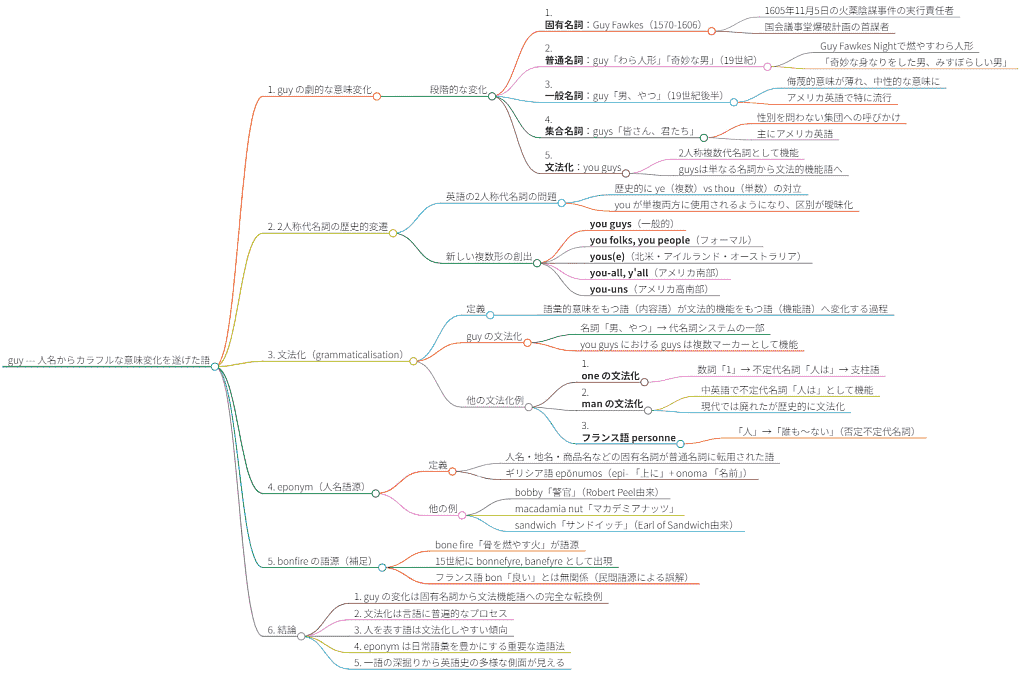
なお,この朝カル講座のシリーズの第1回から第3回についてもマインドマップを作成しています.
・ 「#5857. 2025年度の朝カルシリーズ講座の第1回「she --- 語源論争の絶えない代名詞」をマインドマップ化してみました」 ([2025-05-10-1])
・ 「#5887. 2025年度の朝カルシリーズ講座の第2回「through --- あまりに多様な綴字をもつ語」をマインドマップ化してみました」 ([2025-06-09-1])
・ 「#5915. 2025年度の朝カルシリーズ講座の第3回「autumn --- 類義語に揉み続けられてきた季節語」をマインドマップ化してみました」 ([2025-07-07-1])
・ 「#5949. 2025年度の朝カルシリーズ講座の第4回「but --- きわめつきの多義の接続詞」をマインドマップ化してみました」 ([2025-08-10-1])
シリーズの次回,第6回は,9月27日(土)に「English --- 慣れ親しんだ単語をどこまでも深掘りする」と題して開講されます.ご関心のある方は,ぜひ朝日カルチャーセンター新宿教室の公式HPより詳細をご確認の上,お申し込みいただければ.
2025-08-18 Mon
■ #5957. 8月23日(土),朝カル講座の夏期クール第2回「guy --- 人名からカラフルな意味変化を遂げた語」が開講されます [asacul][notice][personal_pronoun][eponym][grammaticalisation][semantic_change][kdee][etymology][hel_education][helkatsu]
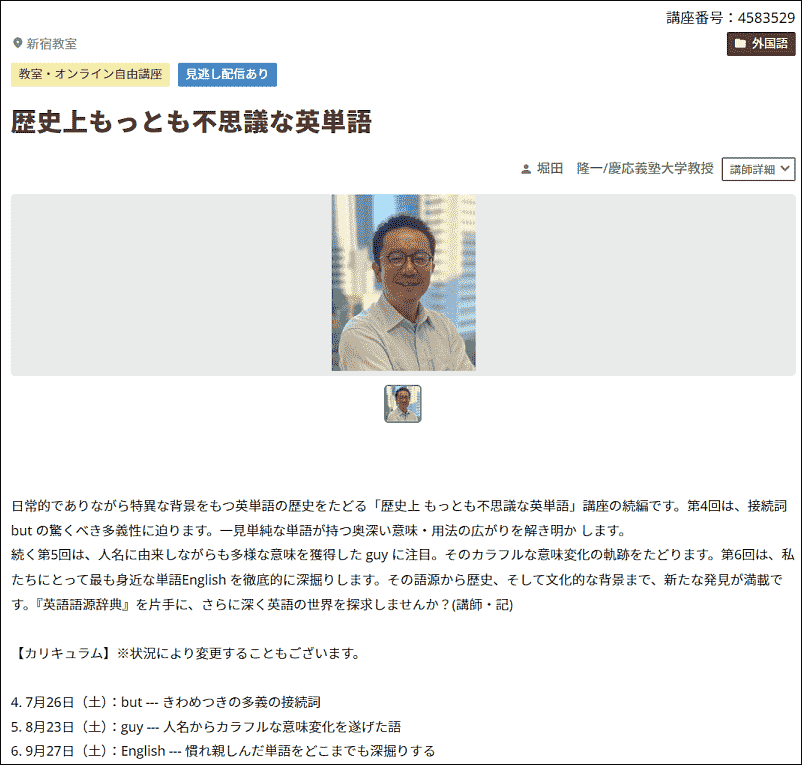
朝日カルチャーセンター新宿教室での英語史講座が続いています.月一のペースで進行中のこのシリーズでは,「歴史上もっとも不思議な英単語」というテーマを掲げています.歴史の厚みを感じさせる語彙を一語ずつじっくりと味わい,『英語語源辞典』(研究社)等の信頼できる資料を手がかりに,言葉の変遷がもたらす驚きと発見に迫っています.
今度の土曜日8月23日の講座は夏期クールの2回目を迎えます.一見すると平凡な guy という語に焦点を絞り,この小さな単語がたどってきた劇的な意味の軌跡をたどることから話を始めます.その流れから人称代名詞 (personal_pronoun) の話題,文法化 (grammaticalisation) の問題,そして固有名詞に由来するeponymの事例相まで,話題は自在に広がっていきます.1単語から見えてくる英語史のダイナミズムと言語変化の妙味を存分にお楽しみください.
参加方法は新宿教室での直接受講,オンライン参加のいずれかをお選びいただけます.さらに2週間の見逃し配信サービスもご用意しております.皆さんのご都合のよい方法でご参加ください.申込み詳細は朝カルの公式ページでご確認いただけます.
なお,この講座の見どころについては heldio で「#1539. 8月23日の朝カル講座 --- guy で味わう英語史」としてお話ししています.こちらもあわせてお聴きいただければ幸いです.
・ 寺澤 芳雄(編集主幹) 『英語語源辞典』新装版 研究社,2024年.
2025-07-20 Sun
■ #5928. 多義語 but [but][polysemy][conjunction][preposition][adverb][verb][noun][hee][grammaticalisation]
but は数ある英単語のなかでも,とりわけ多くの品詞を兼任し,様々な用法を示す,すこぶる付きの多義語である.『英語語源ハンドブック』で but の項目を引くと,まず冒頭に次のようにある.
(接)しかし,…でなければ (前)…以外に,…を除いては (副)ほんの
『英語語源ハンドブック』では各項目にキャッチコピーが与えられているが,but に付されているのは「「しかし」と「…以外に」の接点」である.
語源としては古英語の接頭辞 be- と副詞 utan "out" の組み合わせと考えられ,about とも関係する.古英語からすでに多様な意味・用法が展開しており,それ以前の発達の順序は明確ではないが,次のようなものだったかと推測される.
まず,語の成り立ちから示唆されるように,本来は物理的に「(…の)外側に」という意味の副詞・前置詞だった.これが前置詞で抽象的な領域に拡張し,「…以外に」という意味で使われるようになった(→メタファー).また,前置詞の用法において,名詞句だけでなく that 節も後続するようになり,「…という事態・状況の外側では,…でなければ」という意味を表すようになった.現在最も主要な等位接続詞としての用法(「しかし」)は,この「…でなければ」が拡張・発展した用法だと考えられる.なお, but の接続詞用法は古英語でも確認されるが,主に中英語から使われる用法である.古英語では ac という語が一般的な逆接の等位接続詞だった.「ほんの」という副詞用法は,最近まで用例 が中英語以降しか認められていなかったこともあり,nothing but ...(…以外の何物でもない,…に過ぎない)のような表現における否定語の省略から始まったと考えられてきたが,最近は古英語でもこの用法が確認されていることから,必ずしもそのような発達ではないと考えられている.
この発達経路によれば,現代英語で最も普通の用法である等位接続詞の「しかし」は,意外と後からの発達だったことになる.これほど当たり前の単語にも,一筋縄では行かない歴史が隠されている.
・ 唐澤 一友・小塚 良孝・堀田 隆一(著),福田 一貴・小河 舜(校閲協力) 『英語語源ハンドブック』 研究社,2025年.
2025-05-29 Thu
■ #5876. 完了進行形の初例は後期中英語期 [tense][progressive][perfect][verb][aspect][eme][grammaticalisation]
Visser (§2148) によると,'He has been crying' や 'He had been crying' のタイプの完了進行形は,後期中英語期の Cursor Mundi に初例が確認される.
13.. Curs, M. 5256 he three dais had fastand bene. | Ibid. 10305, fastand had he lang noght bene. | Ibid. 14240, mari and martha had been wepand þar four dais. | Ibid. 26292, if þi parischen In sin lang has ligand bene. | Ibid. 28176, Oft haue i bene ouer mistrauand. | Ibid. 28941, þin almus agh þou for to bede, And namli til him þat has bene Hauand ..., And falles in-to state o nede plight-less.
この後も Chaucer を含めた後期中英語のテキストからの用例が続く.ただし,最も早い例が後期中英語期にいくつか確認されるからといって,必ずしも現代英語の水準で確立されているような1つの時制として,当時すでに頻繁に用いられていたということではない.実際,論者のなかには,その確立は近代英語期以降である,場合によっては後期近代英語期であると述べているものもある.Visser 自身は上記の同じ節にて,次のように説いている.
These types, traditionally called the 'perfect progressive' or 'expanded perfect' and the 'pluperfect progressive' or 'expanded pluperfect', are not represented in Old English. They appear for the first time on paper in the 14th century, and it took them about a century to develop into a well-established and not infrequently used idiom. In the subjoined list all the 14th, 15th, 16th and 17the century instances available are mentioned (and it is therefore not a selection like the rest), in order to show the erroneousness of various statements concerning date of earliest appearance and the incidence in earlier English (often called 'rare').. Thus Åkerlund (1911 p. 85) states: "These tenses do not occur in Old English, nor in the earlier part of the subsequent period. Later on, they creep slowly into existence---even as late as Shakespeare there are strikingly scarce; but they are not employed frequently enough." Kisbye (An Historical Outline of Eng. Syntax I 1971 p. 47) observes: "The expanded pluperfect was instance only once [italics added] in Northern ME ...---This compound tense ... being uncommon till the 19th century [italics added]." In Barbara Strang's The History of English (1970 pp. 207--8) it is averred that the periphrastic perfect did not become fully current till the 18th century, and that the periphrastic pluperfect showed its full maturity fro the time of the Restoration. (But see e.g. the quotations from Lord Berners below). As to her statement that a pluperfect progressive arose "a little earlier [than a perfect progressive] in the 14th century", see earliest examples of the perfect progressive is from Chaucer's Canterbury Tales (1386).
論者間によって捉え方に幅があったということは,用例収集の精度に差があり,事実が共有されていなかったということだろう.一方で,過去完了進行形の出現のほうが,現在完了進行形に先立っていたという事実は興味深い.
・ Visser, F. Th. An Historical Syntax of the English Language. 3 vols. Leiden: Brill, 1963--1973.
2024-12-20 Fri
■ #5716. 保坂先生との heldio 対談シリーズ --- 冠詞と do の文法化について [voicy][heldio][grammaticalisation][article][do-periphrasis][review][notice]
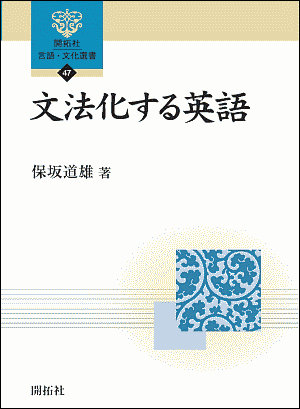
先日,保坂道雄先生(日本大学)と Voicy heldio にて文法化にまつわる対談を2回にわたってお届けしました.開拓社より2014年に出版されたご著書『文法化する英語』を参照しながら,英語史における文法化の具体的な事例について,著者じきじきに解説していただくという贅沢な企画です.2回の配信を以下に挙げておきます.
・ 「#1290. 冠詞の文法化 --- 保坂先生との対談」(2024年12月10日配信)
・ 「#1293. 助動詞 do の文法化 --- 保坂先生との対談」(2024年12月13日配信)
英語史上,きわめて重要な文法化の2つの事例,冠詞の創発と do 迂言法の発展について丁寧に解説していただきました.これらの問題に関心をもった方は,本ブログより article や do-periphrasis のタグの付された記事群を読んでいただければと思います.
上記配信内でも触れていますが,保坂先生との文法化をめぐる heldio 対談回は,以前にも1度配信しています.本ブログより「#5674. 保坂道雄先生との対談 --- ご著書『文法化する英語』(開拓社,2014年)より」 ([2024-11-08-1]) を,あるいは直接 heldio 「#1245. 保坂道雄先生との「文法化入門」対談 --- 「英語史ライヴ2024」より」をご参照ください.
おまけとして,今回の保坂先生との対談にあたって「#1298. 保坂先生とのアフタートークでコメント返し」(2024年12月18日配信)も収録しています.こちらは肩の凝らないおしゃべり回ですので,ぜひお聴きいただければ.
・ 保坂 道雄 『文法化する英語』 開拓社,2014年.
2024-12-17 Tue
■ #5713. 生成文法と言語変化・英語史を掛け合わせた著書が出ました --- 田中 智之・縄田 裕幸・柳 朋宏(著)『生成文法と言語変化』(開拓社,2024年) [generative_grammar][language_change][grammaticalisation][syntax][review][toc][notice]
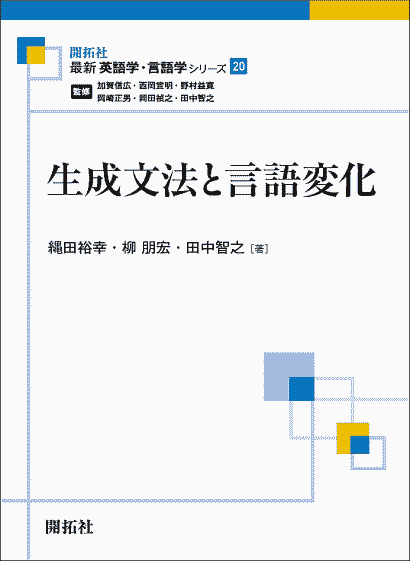
標記の開拓社からの新刊書をご献本いただきました,ありがとうございます!
開拓社による「最新英語学・言語学シリーズ」の第20巻という位置づけで,「生成文法×英語史」の最新の専門的な知見がまとめられています.300頁ほどの著書で,量的にも本格派です.英語の統語変化を理論的に考察したい研究者・学生にとって,必携の参考書です.
以下,目次を取り出してみましょう.魅力的な話題と高度な専門用語が並んでいます.
第I部 生成文法理論における言語変化
第1章 生成文法の理論的枠組みと言語変化
1. はじめに:英語史の時代区分
2. 生成文法の理論的枠組み
3. 文法変化としての言語変化
第2章 言語変化のタイプ
1. 再分析とパラメター変化
2. 文法化:不定詞標識 to を例として
3. 語順変化
4. 項構造の変化:心理動詞を例として
第II部 英語の節構造の変化
第3章 初期英語の節構造と動詞移動の消失
1. はじめに
2. 古英語・初期中英語の基本語順
3. 古英語・初期中英語の節構造
4. 動詞移動と豊かな一致の仮説
5. 屈折接辞の衰退と動詞移動の消失
6. 文法化による語彙動詞から助動詞への変化
7. まとめ
第4章 主語位置の変遷と各種構文の変化
1. はじめに
2. 空主語構文
3. 奇態格経験者主語構文
4. 他動詞虚辞構文
5. that 痕跡効果
6. まとめ
第III部 英語名詞句の構造と分布
第5章 非構造格の消失と格による名詞句の認可方法の変化
1. はじめに
2. 格に関する経験的事実と理論的仮定
3. 与格名詞をともなう構文の歴史的変遷
4. 与格名詞の認可と認可方法の変化
5. まとめ
第6章 数量詞の分布と遊離可能性の通時的変遷
1. はじめに
2. 初期英語における数量詞の分布
3. 理論的仮定
4. 遊離数量詞の分布に関する通時的変化
5. 代名詞と数量詞の語順
6. まとめ
本書については,12月11日に Voicy heldio にて「#1291. 田中 智之・縄田 裕幸・柳 朋宏(著)『生成文法と言語変化』(開拓社,2024年)」の配信回でもご紹介しています.本記事と合わせてお聴きいただければ.
本書と関連して,開拓社の「最新英語学・言語学シリーズ」の第21巻,家入 葉子・堀田 隆一(著)『文献学と英語史研究』(開拓社,2022年)もどうぞよろしくお願い致します.
・ 田中 智之・縄田 裕幸・柳 朋宏 『生成文法と言語変化』 開拓社,2024年.
2024-11-08 Fri
■ #5674. 保坂道雄先生との対談 --- ご著書『文法化する英語』(開拓社,2014年)より [review][grammaticalisation][voicy][heldio][hellive2024][khelf][do-periphrasis][perfect][language_change][link]

9月8日(日)に khelf(慶應英語史フォーラム)主催で開かれた「英語史ライヴ2024」の1セッションとして,『文法化する英語』(開拓社,2014年)の著者である保坂道雄先生(日本大学教授)と初の heldio 対談が実現しました.
文法化 (grammaticalisation) の入門となる音声コンテンツとなっていますが,そればかりでなく保坂先生の言語(変化)観をお聴きする貴重な機会ともなっています.対談の際,私の収録態勢が不十分だったために,途中部分を録音できなかったという痛恨のミスを犯してしまいましたが,全体としては一貫したコンテンツとなっております.ぜひお聴きいただければと思います.「#1245. 保坂道雄先生との「文法化入門」対談 --- 「英語史ライヴ2024」より」です(本編は20分弱です).
第2チャプターでは,言語変化における文法化の位置づけ,および迂言的 do (do-periphrasis) の文法化のイントロについてお話ししていただきました.続く第3チャプターでは,完了形 (perfect) の文法化を導入していただきました.(収録に失敗してしまった do 迂言形の話題につきましては,後日,改めて保坂先生にじっくりお話しいただきたいと思っています.)
今回の対談でご紹介した『文法化する英語』や,そこで扱われている個々の文法化の事例については,これまでも hellog および heldio で様々に取り上げてきました.文法化に関わるとりわけ重要なコンテンツを以下に一覧しておきます.
【 hellog 記事 】
・ 「#1972. Meillet の文法化」 ([2014-09-20-1])
・ 「#1974. 文法化研究の発展と拡大 (1)」 ([2014-09-22-1])
・ 「#1975. 文法化研究の発展と拡大 (2)」 ([2014-09-23-1])
・ 「#2144. 冠詞の発達と機能範疇の創発」 ([2015-03-11-1])
・ 「#2146. 英語史の統語変化は,語彙投射構造の機能投射構造への外適応である」 ([2015-03-13-1])
・ 「#2490. 完了構文「have + 過去分詞」の起源と発達」 ([2016-02-20-1])
・ 「#2575. 言語変化の一方向性」 ([2016-05-15-1])
・ 「#2576. 脱文法化と語彙化」 ([2016-05-16-1])
・ 「#3272. 文法化の2つのメカニズム」 ([2018-04-12-1])
・ 「#3273. Lehman による文法化の尺度,6点」 ([2018-04-13-1])
・ 「#3281. Hopper and Traugott による文法化の定義と本質」 ([2018-04-21-1])
・ 「#3669. ゼミのグループ研究のための取っ掛かり書誌」 ([2019-05-14-1])
・ 「#5124. Oxford Bibliographies による文法化研究の概要」 ([2023-05-08-1])
・ 「#5132. なぜ be going to は未来を意味するの? --- 「文法化」という観点から素朴な疑問に迫る」 ([2023-05-16-1])
・ 「#5411. heldio で「文法化」を導入するシリーズをお届けしました」 ([2024-02-19-1])
・ 「#5420. 保坂道雄(著)『文法化する英語』(開拓社,2014年) --- 英語の文法化の入門書」 ([2024-02-28-1])
【 heldio コンテンツ 】
・ 「#988. ぎゅうぎゅうの単語とすかすかの単語 --- 内容語と機能語」
・ 「#989. 内容語と機能語のそれぞれの特徴を比較する」
・ 「#990. 文法化とは何か?」
・ 「#991. while の文法化」
・ 「#992. while の文法化(続き)」
・ 「#1001. 英語の文法化について知りたいなら --- 保坂道雄(著)『文法化する英語』(開拓社,2014年)」
・ 「#1003. There is an apple on the table. --- 主語はどれ?」
英語史の視点からの文法化の入門書として,改めて保坂先生著『文法化する英語』を推します.
・ 保坂 道雄 『文法化する英語』 開拓社,2014年.
2024-11-07 Thu
■ #5673. 10月,Mond で5件の質問に回答しました [mond][sobokunagimon][hel_education][notice][link][helkatsu][numeral][grammaticalisation][number][category][dual][negation][perfect][subjunctive][heldio]
先月,知識共有サービス Mond にて5件の英語に関する質問に回答しました.新しいものから遡ってリンクを張り,回答の要約も付します.
(1) なぜ数量詞は遊離できるのに,冠詞や所有格は遊離できないの?
回答:理論的には数量詞句 (QP) と限定詞句 (DP) の違いによるものと説明できそうですが,一筋縄では行きません.歴史的にいえば,古英語から現代英語に至るまで,数量詞遊離は常に存在していましたが,時代とともに制限が厳しくなってきているという事実があります.詳しくは新刊書の田中 智之・縄田 裕幸・柳 朋宏(著)『生成文法と言語変化』(開拓社,2024年)をご参照ください.
(2) have got to の got とは何なのでしょうか?
回答:have got は本来「獲得したところだ」という現在完了の意味でしたが,16世紀末から「持っている」という単純な意味に転じました.文法化 (grammaticalisation) の過程を経て,口語で have の代用として定着しています.「#5657. 迂言的 have got の発達 (1)」 ([2024-10-22-1]),「#5658. 迂言的 have got の発達 (2)」 ([2024-10-23-1]) を参照.
(3) 英語では単数形,複数形の区別がありますが,なぜ「1とそれ以外」なのでしょうか?
回答:「1」が他の数と比べて特に基本的で重要な数であるためと考えられます.古英語には双数形もありましたが,中英語以降は単数・複数の2区分となりました.世界の言語では最大5区分まで持つものもあります.「#5660. なぜ英語には単数形と複数形の区別があるの? --- Mond での質問と回答より」 ([2024-10-25-1]) を参照.
(4) 完了形はなぜ動作の継続を表現できるのでしょうか?
回答:完了形の諸用法の共通点は「現在との関与」です.継続の意味は主に状態動詞で現われ,動作動詞では完了の意味が表出します.また「時間的不定性」も完了形の重要な特徴と考えられます.「#5651. 過去形に対する現在完了形の意味的特徴は「不定性」である」 ([2024-10-16-1]) を参照.
(5) subjunctive mood (仮定法・接続法)の現在完了について
回答:仮定法現在完了は理論上存在可能で実例も見られますが,比較的まれです.仮定法の体系は「現在・過去・過去完了」の3つ組みとして理解するのが妥当で,その中で完了相が必要な場合に現在完了形が使用される,と解釈するのはいかがでしょうか.
以上です.11月も Mond にて英語(史)に関する素朴な疑問を受け付けています.気になる問いをお寄せください.
2024-10-23 Wed
■ #5658. 迂言的 have got の発達 (2) [periphrasis][grammaticalisation][have][perfect][participle][emode][auxiliary_verb]
昨日の記事「#5657. 迂言的 have got の発達 (1)」 ([2024-10-22-1]) に引き続き,現代では日常的となったこの迂言的表現について.
Rissanen (220) が,初期近代英語期の統語論を論じている文献にて,同表現の発生について言及している.
The perfect have got, which is almost a rule, instead of the present tense have, in colloquial present-day British English, is attested from the end of the sixteenth century. The periphrastic form here is possibly due to a tendency to increase the weight of the verbal group, particularly in sentence-final position. The association of have with the auxiliaries may have supported the development of the two-verb structure.
(173) Some have got twenty four pieces of ivory cut in the shape of dice, . . . and with these they have played at vacant hours with a childe ([HC] Hoole 7)
(174) Bon. What will your Worship please to have for Supper?
Aim. What have you got?
Bon. Sir, we have a delicate piece of Beef in the Pot . . .
Aim. Have you got any fish or Wildfowl? ([HC] Farquhar I.i)
迂言形の出現の背景として考えられる事柄を2点挙げている.1つめは,複合動詞とすることで韻律的な「重み」が増し,語呂がよくなるということだ.とりわけ文末において動詞(過去分詞)の got が現われると口語では好韻律になるということだが,これはどこまで実証されるのだろうか,気になるところである.
もう1つは,have が助動詞として振る舞うようになっていたために,後ろに got のような別の動詞が接続し,2語で複合動詞として機能することは,統語的に自然なことだ,という洞察である.ただし,「have + 過去分詞」が現在完了を表わすというのは,すでに中英語期から普通のことだった.とりわけ have got の迂言形が発達してきたはなぜかを積極的に説明するような洞察ではない.
17世紀(以降)の口語における用例と文脈を詳しく調査していく必要がある.
・ Rissanen, Matti. "Syntax." The Cambridge History of the English Language. Vol. 3. Cambridge: CUP, 1999. 187--331.
2024-10-22 Tue
■ #5657. 迂言的 have got の発達 (1) --- Mond での質問と回答より [periphrasis][have][perfect][participle][grammaticalisation][emode][mond][sobokunagimon][eebo]

知識共有サービス Mond に寄せられていた「迂言的 have got」に関する素朴な疑問に,先日回答しました.こちらよりお読みください.本当はもっと詳しく調べなければならない問題で,今回はとりあえずの回答だったのですが,これを機に考え始めてみたいと思います.
最初の一歩は,いつでも OED です.迂言的 have got は,OED の get (v.) の IV の項に,完了形の特殊用法として記述があります.
IV. Specialized uses of the perfect.
In this use, the perfect and past perfect of get (have got, has got, had got) function as a present and past tense verb, which, owing to its formation, does not enter into further compound forms (perfect and past perfect, progressive, passive, or periphrastic expressions with to do), or have an imperative or infinitive.
In colloquial, regional, and nonstandard use, omission of auxiliary have is frequent in the uses at this branch (e.g. I got some, you got to): see examples in etymology section. An inflected form gots is also sometimes found in similar use (e.g. I gots some, he gots to), especially in African American usage: see further examples in etymology section.
IV.i. In senses equivalent to those of the present and past tenses of have.
Often, especially in early use, difficult to distinguish from the dynamic use 'have obtained or acquired'.
IV.i.33.a. transitive. To hold as property, be in possession of, own; to possess as a part, attribute, or characteristic; = have v. I.i
[1600 What a beard hast thou got; thou hast got more haire on thy chinne, then Dobbin my philhorse hase on his taile.
W. Shakespeare, Merchant of Venice]
1611 The care of conseruing and increasing the goods they haue got, and the feare of loosing that which they enioy.
J. Maxwell, translation of Treasure of Tranquillity xvii. 144
a1616 Fie, th'art a churle, ye'haue got a humour there Does not become a man.
W. Shakespeare, Timon of Athens (1623) i.ii.25
c1635 My lady has got a cast of her eye.
H. Glapthorne, Lady Mother (1959) ii.i.22
1670 They have got..such a peculiar Method of Text-dividing.
J. Eachard, Grounds Contempt of Clergy 113
. . . .
have got が本来の動作的な意味を表わすのか,現代風の状態的な意味を表わすのか,特に初期の例については判別しにくいケースがあると述べられてはいますが,17世紀中に頻度を高めていったことは EEBO corpus で調べた限り間違いなさそうです.なぜ,どのような経緯でこの表現が現われ,一般的になっていったのか,深掘りしていく必要があります.
2024-10-01 Tue
■ #5636. 9月下旬,Mond で10件の疑問に回答しました [mond][sobokunagimon][hel_education][notice][link][helkatsu][adjective][slang][derivation][demonym][perfect][grammaticalisation][h][word_order][syntax][final_e][subjectification][intersubjectification][personal_pronoun][gender]

10月が始まりました.大学の新学期も開始しましたので,改めて「hel活」 (helkatsu) に精を出していきたいと思います.9月下旬には,知識共有サービス Mond にて10件の英語に関する質問に回答してきました.今回は,英語史に関する素朴な疑問 (sobokunagimon) にとどまらず進学相談なども寄せられました.新しいものから遡ってリンクを張り,回答の要約も付します.
(1) なぜ英語にはポジティブな形容詞は多いのにネガティヴな形容詞が少ないの?
回答:英語にはポジティヴな形容詞もネガティヴな形容詞も豊富にありますが,教育的配慮や社会的な要因により,一般的な英語学習ではポジティヴな形容詞に触れる機会が多くなる傾向がありそうです.実際の言語使用,特にスラングや口語表現では,ネガティヴな形容詞も数多く存在します.
(2) 地名と形容詞の関係について,Germany → German のように語尾を削る物がありますが?
回答:国名,民族名,言語名などの関係は複雑で,どちらが基体でどちらが派生語かは場合によって異なります.歴史的な変化や自称・他称の違いなども影響し,一般的な傾向を指摘するのは困難です.
(3) 現在完了の I have been to に対応する現在形 *I am to がないのはなぜ?
回答:have been to は18世紀に登場した比較的新しい表現で,対応する現在形は元々存在しませんでした.be 動詞の状態性と前置詞 to の動作性の不一致も理由の一つです.「現在完了」自体は文法化を通じて発展してきました.
(4) 読まない語頭以外の h についての研究史は?
回答:語中・語末の h の歴史的変遷,2重字の第2要素としてのhの役割,<wh> に対応する方言の発音,現代英語における /h/ の分布拡大など,様々な観点から研究が進められています.h の不安定さが英語の発音や綴字の発展に寄与してきた点に注目です.
(5) 言語による情報配置順序の特徴と変化について
回答:言語によって言語要素の配置順序に特有の傾向があり,これは語順,形態構造,音韻構造など様々な側面に現われます.ただし,これらの特徴は絶対的なものではなく,歴史的に変化することもあります.例えば英語やゲルマン語の基本語順は SOV から SVO へと長い時間をかけて変化してきました.
(6) なぜ come や some には "magic e" のルールが適用されないの?
回答:come,some などの単語は,"magic e" のルールとは無関係の歴史を歩んできました.これらの単語の綴字は,縦棒を減らして読みやすくするための便法から生まれたものです.英語の綴字には多数のルールが存在し,"magic e" はそのうちの1つに過ぎません.
(7) Let's にみられる us → s の省略の類例はある? また,意味が変化した理由は?
回答:us の省略形としての -'s の類例としては,shall's (shall us の約まったもの)がありました.let's は形式的には us の弱化から生まれましたが,機能的には「許可の依頼」から「勧誘」へと発展し,さらに「なだめて促す」機能を獲得しました.これは言語の主観化,間主観化の例といえます.
(8) 英語にも日本語の「拙~」のような1人称をぼかす表現はある?
回答:英語にも謙譲表現はありますが,日本語ほど体系的ではありません.例えば in my humble opinion や my modest prediction などの表現,その他の許可を求める表現,著者を指示する the present author などの表現があります.しかし,これらは特定の語句や慣用表現にとどまり,日本語のような体系的な待遇表現システムは存在しません.
(9) 英語史研究者を目指す大学4年生からの相談
回答:大学卒業後に社会経験を積んでから大学院に進学するキャリアパスは珍しくありません.教育現場での経験は研究にユニークな視点をもたらす可能性があります.研究者になれるかどうかの不安は多くの人が抱くものですが,最も重要なのは持続する関心と探究心,すなわち情熱です.研究会やセミナーへの参加を続け,学びのモチベーションを保ってください.
(10) 英語の人称代名詞における性別区分の理由と新しい代名詞の可能性は?
回答:1人称・2人称代名詞は会話の現場で性別が判断できるため共性的ですが,3人称単数代名詞は会話の現場にいない人を指すため,明示的に性別情報が付されていると便利です.現代では性の多様性への認識から,新しい共性の3人称単数代名詞が提案されていますが,広く受け入れられているのは singular they です.今後も要注目の話題です.
以上です.10月も Mond より,英語(史)に関する素朴な疑問をお寄せください.
2024-07-14 Sun
■ #5557. 秋元実治(著)『増補 文法化とイディオム化』(ひつじ書房,2014年) [toc][grammaticalisation][idiomatisation][idiom][composite_predicate][syntax][lexicology][frequency][lexicalisation][preposition][phrasal_verb][voicy][heldio]
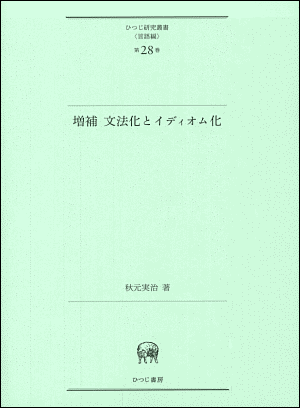
先日,秋元実治先生(青山学院大学名誉教授)と標記の書籍を参照しつつ対談しました.そして,その様子を一昨日 Voicy heldio で「#1139. イディオムとイディオム化 --- 秋元実治先生との対談 with 小河舜さん」として配信しました.中身の濃い,本編で22分ほどの対談回なっております.ぜひお時間のあるときにお聴きください.
秋元実治(著)『増補 文法化とイディオム化』(ひつじ書房,2014年)については,これまでもいくつかの記事で取り上げてきており,とりわけ「#1975. 文法化研究の発展と拡大 (2)」 ([2014-09-23-1]) で第1章の目次を挙げましたが,今回は今後の参照のためにも本書全体の目次を掲げておきます.近日中に対談の続編を配信する予定です.
改訂版はしがき
はしがき
理論編
第1章 文法化
1.1 序
1.2 文法化とそのメカニズム
1.2.1 語用論的推論 (Pragmatic inferencing)
1.2.2 漂白化 (Bleaching)
1.3 一方向性 (Unidirectionality)
1.3.1 一般化 (Generalization)
1.3.2 脱範疇化 (Decategorialization)
1.3.3 重層化 (Layering)
1.3.4 保持化 (Persistence)
1.3.5 分岐化 (Divergence)
1.3.6 特殊化 (Specialization)
1.3.7 再新化 (Renewal)
1.4 主観化 (Subjectification)
1.5 再分析 (Reanalysis)
1.6 クラインと文法化連鎖 (Grammaticalization chains)
1.7 文法化とアイコン性 (Iconicity)
1.8 文法化と外適応 (Exaptation)
1.9 文法化と「見えざる手」 (Invisible hand) 理論
1.10 文法化と「偏流」 (Drift) 論
第2章 イディオム化
2.1 序
2.2 イディオムとは
2.3 イディオム化
2.4 イディオム化の要因
2.4.1 具体的から抽象的
2.4.2 脱範疇化 (Decategorialization)
2.4.3 再分析 (Reanalysis)
2.4.4 頻度性 (Frequency of occurrence)
2.5 イディオム化,文法化及び語彙化
分析例
第1章 初期近代英語における複合動詞の発達
1.1 序
1.2 先行研究
1.3 データ
1.4 複合動詞のイディオム的特徴
1.4.1 Give
1.4.2 Take
1.5 ジャンル間の比較: The Cely Letters と The Paston Letters
1.6 結論
第2章 後期近代英語における複合動詞
2.1 序
2.2 先行研究
2.3 データ
2.4 構造の特徴
2.5 関係代名詞化
2.6 各動詞の特徴
2.6.1 Do
2.6.2 Give
2.6.3 Have
2.6.4 Make
2.6.5 Take
2.7 複合動詞と文法化
2.8 結論
第3章 Give イディオムの形成
3.1 序
3.2 先行研究
3.3 データ及び give パタンの記述
3.4 本論
3.4.1 文法化とイディオム形成
3.4.2 再分析と意味の漂白化
3.4.3 イディオム化
3.4.4 名詞性
3.4.5 構文と頻度性
3.4 本論
3.4.1 文法化とイディオム形成
3.4.2 再分析と意味の漂白化
3.4.3 イディオム化
3.4.4 名詞性
3.4.5 構文と頻度性
3.5 結論
第4章 2つのタイプの受動構文
4.1 序
4.2 先行研究
4.3 データ
4.4 イディオム化
4.5 結論
第5章 再帰動詞と関連構文
5.1 序
5.2 先行研究
5.3 データ
5.3.1 Content oneself with
5.3.2 Avail oneself of
5.3.3 Devote oneself to
5.3.4 Apply oneself to
5.3.5 Attach oneself to
5.3.6 Address oneself to
5.3.7 Confine oneself to
5.3.8 Concern oneself with/about/in
5.3.9 Take (it) upon oneself to V
5.4 再帰動詞と文法化及びイディオム化
5.5 再起動し,受動化及び複合動詞
5.5.1 Prepare
5.5.2 Interest
5.6 結論
第6章 Far from の文法化,イディオム化
6.1 序
6.2 先行研究
6.3 データ
6.4 文法化とイディオム化
6.4.1 文法化
6.4.2 意味変化と統語変化の関係:イディオム化
6.5 結論
第7章 複合前置詞
7.1 序
7.2 先行研究
7.3 データ
7.4 複合前置詞の発達
7.4.1 Instead of
7.4.2 On account of
7.5 競合関係 (Rivalry)
7.5.1 In comparison of/in comparison with/in comparison to
7.5.2 By virtue of/in virtue of
7.5.3 In spite of/in despite of
7.6 談話機能の発達
7.7 文法化,語彙化,イディオム化
7.8 結論
第8章 動詞派生前置詞
8.1 序
8.2 先行研究
8.3 データ及び分析
8.3.1 Concerning
8.3.2 Considering
8.3.3 Regarding
8.3.4 Relating to
8.3.5 Touching
8.4 動詞派生前置詞と文法化
8.5 結論
第9章 動詞 pray の文法化
9.1 序
9.2 先行研究
9.3 データ
9.4 15世紀
9.5 16世紀
9.6 17世紀
9.7 18世紀
9.8 19世紀
9.9 文法化
9.9.1 挿入詞と文法化
9.9.2 丁寧標識と文法化
9.10 結論
第10章 'I'm afraid' の挿入詞的発達
10.1 序
10.2 先行研究
10.3 データ及びその文法
10.4 文法化---Hopper (1991) を中心に
10.5 結論
第11章 'I dare say' の挿入詞的発達
11.1 序
11.2 先行研究
11.3 データの分析
11.4 文法化と文体
11.5 結論
第12章 句動詞における after と forth の衰退
12.1 序
12.2 For による after の交替
12.2.1 先行研究
12.2.2 動詞句の選択と頻度
12.2.3 After と for の意味・機能の変化
12.3 Forth の衰退
12.3.1 先行研究
12.3.2 Forth と共起する動詞の種類
12.3.3 Out による forth の交替
12.4 結論
第13章 Wanting タイプの動詞間に見られる競合 --- desire, hope, want 及び wish を中心に ---
13.1 序
13.2 先行研究
13.3 昨日変化
13.3.1 Desire
13.3.2 Hope
13.3.3 Want
13.3.4 Wish
13.4 4つの動詞の統語的・意味的特徴
13.4.1 従属節内における法及び時制
13.4.1.1 Desire + that/Ø
13.4.1.2 Hope + that/Ø
13.4.1.3 Wish + that/Ø
13.4.2 Desire, hope, want 及び wish と to 不定詞構造
13.4.3 That の省略
13.5 新しいシステムに至る変化及び再配置
13.6 結論
結論
補章
参考文献
索引
人名索引
事項索引
・ 秋元 実治 『増補 文法化とイディオム化』 ひつじ書房,2014年.
2024-05-24 Fri
■ #5506. be to do 構文は古英語からあった [be_to_do][syntax][infinitive][auxiliary_verb][oe][impersonal_verb][construction][grammaticalisation]
英語には be to do 構文というものがある.be 動詞の後に to 不定詞が続く構文で,予定,運命,義務・命令,可能,意志など様々な意味をもち,英語学習者泣かせの項目である.この文法事項については「#4104. なぜ He is to blame. は He is to be blamed. とならないのですか? --- hellog ラジオ版」 ([2020-07-22-1]) で少し触れた.
では,be to do 構文の歴史はいかに? 実は非常に古くからあり,古英語でもすでに少なくとも「構文の種」として確認される.古英語では高頻度に生起するわけではないが,中英語以降では頻度も増し,現代的な「構文」らしいものへと成長していく.近代英語にかけては,他の構文とタグも組めるほどに安定性を示すようになった.長期にわたる文法化 (grammaticalisation) の1例といってよい.
先行研究は少なくないが,ここでは Denison (317--18) の解説を示そう.長期にわたる発達が手短かにまとめられている.
11.3.9.3 BE of necessity, obligation, or future
This verb too is a marginal modal, patterning with a to-infinitive to express meanings otherwise often expressed by modals. For Old English see Mitchell (1985: §§934--49), and more generally Visser (1963--73: §§1372--83). One complication is that the syntagm BEON + to-infinitive is used both personally [158] and impersonally [159]:
[158] Mt(WSCp) 11.3
. . . & cwað eart þu þe to cumenne eart . . .
. . . and said are(2 SG) you(2 SG) that (REL) to come are(2 SG)
Lat. . . . ait illi tu es qui uenturus es
'. . . and said: "Are you he that is to come?"'
[159] ÆLS I 10.133
us nys to cweðenne þæt ge unclæne syndon
us(DAT) not-is to say that you unclean are
'It is not for us to say that you are unclean.'
In Middle and Modern English this BE had a full paradigm:
[160] 1660 Pepys, Diary I 193.7 (5 Jul)
. . . the King and Parliament being to be intertained by the City today with great pomp.
[161] 1667 Pepys, Diary VIII 452.6 (27 Sep)
Nay, several grandees, having been to marry a daughter, . . . have wrote letters . . .
[162] 1816 Austen, Mansfield Part I.xiv.135.30
You will be to visit me in prison with a basket of provisions;
Visser states that syntagms with infinitive be are 'still current' (1963--73: §2135), but although there are a few relevant examples later than Jane Austen (1963--73: §§1378, 2135, 2142), most are of the fixed idiom BE to come, as in:
[163] But they may yet be to come.
まとめると,be to do 構文は古英語からその萌芽がみられ,中英語から近代英語にかけておおいに発達した.一時は他の構文とも組める統語的柔軟性を獲得したが,現代にかけてはむしろ柔軟性を失い,統語的には単体で用いられるようになり,現代に至る.
・ Denison, David. English Historical Syntax. Longman: Harlow, 1993.
2024-02-28 Wed
■ #5420. 保坂道雄(著)『文法化する英語』(開拓社,2014年) --- 英語の文法化の入門書 [toc][review][grammaticalisation]

英語の文法化 (grammaticalisation) を学び始めたいという方に,標題の入門書をお薦めします.こちらの本については,先日の Voicy 「英語の語源が身につくラジオ (heldio)」でも取り上げました.「#1001. 英語の文法化について知りたいなら --- 保坂道雄(著)『文法化する英語』(開拓社,2014年)」です.ぜひお聴きください.
今朝配信した heldio でも「#1003. There is an apple on the table. --- 主語はどれ?」と題して,本書を参照しながら存在構文の謎についてのお話しをお届けしています.最近の heldio では他にも文法化にまつわる話題をシリーズで配信していますので「#5411. heldio で「文法化」を導入するシリーズをお届けしました」 ([2024-02-19-1]) のリンク集もご参照ください.
さて,『文法化する英語』で取り上げられている英語史上の文法化の事例はたいへんに豊富です.しかも重要な文法項目ばかりです.以下に掲げる目次を見ればわかるかと思います.
はしがき
第1章 文法化と英語
1. はじめに
2. 文法化とは何か
3. 英語の構造
4. 英語の歴史
5. 文法化を動かす「見えざる手」
第2章 冠詞の文法化
1. はじめに
2. 不定冠詞の歴史
3. 定冠詞の歴史
4. 冠詞の出現と文法化
第3章 存在構文における there の文法化
1. はじめに
2. There 構文の発達
3. 虚辞 there の出現と文法化
第4章 所有格の標識 -'s の文法化
1. はじめに
2. 所有格の標識 -'s の文法化
3. of 属格の発達
第5章 接続詞の文法化
1. はじめに
2. 並列構造から従属構造へ
2.1. 古英語における従属構造の発達
2.2. 多様な接続詞の発達
3. 接続詞の文法化
第6章 関係代名詞の文法化
1. はじめに
2. 古英語の関係代名詞
3. 関係代名詞 that の文法化
4. WH 関係代名詞の発達
第7章 再帰代名詞の文法化
1. はじめに
2. 古英語の再帰代名詞
3. 再帰代名詞の文法化
第8章 助動詞 DO の文法化
1. はじめに
2. 古英語の疑問文と否定文
3. DO の文法化
第9章 法助動詞の文法化
1. はじめに
2. 現代英語の法助動詞
3. 法助動詞の文法化
第10章 不定詞標識 to の文法化と準助動詞の発達
1. はじめに
2. 不定詞標識 to の文法化
3. for + 名詞句 + to 不定詞の発達
4. 準助動詞の文法化
4.1. be going to の文法化
4.2. have to の文法化
第11章 進行形の文法化
1. はじめに
2. 古英語の進行表現
3. 進行形の文法化
第12章 完了形の文法化
1. はじめに
2. 古英語の完了表現
2.1. HAVE 完了形
2.2. BE 完了形
3. 完了形の文法化
第13章 受動態の文法化
1. はじめに
2. 受動態の発達
3. 受動態の文法化
4. 二重目的語構文の受動態について
第14章 形式主語 it の文法化
1. はじめに
2. 非人称構文の衰退
3. 虚辞 it の文法化
第15章 文法化と言語進化
1. はじめに
2. 英語の多様な文法化
3. 文法化と構造変化
4. 言語の小進化
5. 英語の格と語順
6. おわりに
主要作品略語表
参考文献
さらなる研究のために
索引
本書は,この hellog でも何度か参照してきました.以下の記事もご覧いただければと思います.いずれにせよ『文法化する英語』は英語史の視点からの文法化の入門書としてイチオシです.
・ 「#2144. 冠詞の発達と機能範疇の創発」 ([2015-03-11-1])
・ 「#2146. 英語史の統語変化は,語彙投射構造の機能投射構造への外適応である」 ([2015-03-13-1])
・ 「#2490. 完了構文「have + 過去分詞」の起源と発達」 ([2016-02-20-1])
・ 「#3669. ゼミのグループ研究のための取っ掛かり書誌」 ([2019-05-14-1])
・ 「#5132. なぜ be going to は未来を意味するの? --- 「文法化」という観点から素朴な疑問に迫る」 ([2023-05-16-1])
・ 保坂 道雄 『文法化する英語』 開拓社,2014年.
2024-02-19 Mon
■ #5411. heldio で「文法化」を導入するシリーズをお届けしました [voicy][heldio][grammaticalisation][notice][hel_education][language_change][link]
毎朝6時に,本ブログの姉妹版ともいえる音声ブログ Voicy 「英語の語源が身につくラジオ (heldio)」を配信しています.2024年の heldio のテーマは言語変化 (language_change) です.大きなテーマなので取り上げていく話題も多岐にわたりますが,避けて通れないものの1つに文法化 (grammaticalisation) があります.本ブログでも「#417. 文法化とは?」 ([2010-06-18-1]) を始めとして,多くの記事で注目してきました.
先週,heldio にて5日連続で文法化の超入門となる話題をお届けしました.結果的に文法化の導入シリーズとなりました.こちらにリンクをまとめておきます.
・ 「#988. ぎゅうぎゅうの単語とすかすかの単語 --- 内容語と機能語」
・ 「#989. 内容語と機能語のそれぞれの特徴を比較する」
・ 「#990. 文法化とは何か?」
・ 「#991. while の文法化」
・ 「#992. while の文法化(続き)」
(以下,後記)
・ 「#1001. 英語の文法化について知りたいなら --- 保坂道雄(著)『文法化する英語』(開拓社,2014年)」
・ 「#1003. There is an apple on the table. --- 主語はどれ?」
(後記,ここまで)
5回の話しはスムーズにつながっているので,順に聴いていただくとよいと思います.手っ取り早く聴きたいという方は,中心回となる「#990. 文法化とは何か?」だけでもシリーズの大枠はつかめると思います.
もっと本格的に文法化を学びたいという方は,本ブログの grammaticalisation の各記事をご覧ください.特に重要な記事をいくつか挙げておきます.
・ 「#1972. Meillet の文法化」 ([2014-09-20-1])
・ 「#1974. 文法化研究の発展と拡大 (1)」 ([2014-09-22-1])
・ 「#1975. 文法化研究の発展と拡大 (2)」 ([2014-09-23-1])
・ 「#2575. 言語変化の一方向性」 ([2016-05-15-1])
・ 「#2576. 脱文法化と語彙化」 ([2016-05-16-1])
・ 「#3273. Lehman による文法化の尺度,6点」 ([2018-04-13-1])
・ 「#3272. 文法化の2つのメカニズム」 ([2018-04-12-1])
・ 「#3281. Hopper and Traugott による文法化の定義と本質」 ([2018-04-21-1])
・ 「#5124. Oxford Bibliographies による文法化研究の概要」 ([2023-05-08-1])
2024-02-12 Mon
■ #5404. 言語は名詞から始まったのか,動詞から始まったのか? [homo_sapiens][origin_of_language][evolution][history_of_linguistics][grammaticalisation][noun][verb][category][name_project][onomastics][naming]
標題は解決しようのない疑問ではあるが,言語学史 (history_of_linguistics) においては言語の起源 (origin_of_language) をめぐる議論のなかで時々言及されてきた問いである.
Mufwene (22) を参照して,2人の論者とその見解を紹介したい.ドイツの哲学者 Johann Gottfried von Herder (1744--1803) とアメリカの言語学者 William Dwight Whitney (1827--94) である.
Herder also speculated that language started with the practice of naming. He claimed that predicates, which denote activities and conditions, were the first names; nouns were derived from them . . . . He thus partly anticipated Heine and Kuteva (2007), who argue that grammar emerged gradually, through the grammaticization of nouns and verbs into grammatical markers, including complementizers, which make it possible to form complex sentences. An issue arising from Herder's position is whether nouns and verbs could not have emerged concurrently. . . .
On the other hand, as hypothesized by William Dwight Whitney . . . , the original naming practice need not have entailed the distinction between nouns and verbs and the capacity to predicate. At the same time, naming may have amounted to pointing with (pre-)linguistic signs; predication may have started only after hominins were capable of describing states of affairs compositionally, combining word-size units in this case, rather than holophrastically.
Herder は言語は名付け (naming) の実践から始まったと考えた.ところが,その名付けの結果としての「名前」が最初は名詞ではなく述語動詞だったという.この辺りは意外な発想で興味深い.Herder は,名詞は後に動詞から派生したものであると考えた.これは現代の文法化 (grammaticalisation) の理論でいうところの文法範疇の創発という考え方に近いかもしれない.
一方,Whitney は,言語は動詞と名詞の区別のない段階で一語表現 (holophrasis) に発したのであり,あくまで後になってからそれらの文法範疇が発達したと考えた.
言語起源論と文法化理論はこのような論点において関係づけられるのかと感心した次第.
・ Mufwene, Salikoko S. "The Origins and the Evolution of Language." Chapter 1 of The Oxford Handbook of the History of Linguistics. Ed. Keith Allan. Oxford: OUP, 2013. 13--52.
Powered by WinChalow1.0rc4 based on chalow